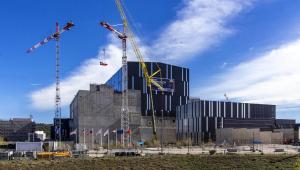There goes the long-standing crane
In October 2014, close to ten years ago, five giant cranes were installed on and around the Tokamak Complex basemat slab. As work progressed to erect the Complex and further lift capacity was required, other cranes were added and strategically positioned to serve the different work areas on the ITER platform. At the peak of construction activity in 2016-2018 a total of nine cranes were operating, with "heights under the hook" ranging from 56 to 84 metres and lift capacities of 20 to 40 tonnes. Crane C2, which was dismantled last week, was one of the original five, a workhorse that handled some of the heaviest loads during the construction and equipping of the Tokamak Building.
Operated by the VFR Consortium, crane C2 was particularly tall (84 metres) and stood on a sturdy lower mast (4 x 4 metres) that reinforced its resistance to the gusts of wind that can be quite violent in Provence. One of the crane's key missions—and one that determined the choice of this specific model in the manufacturer's catalogue—was to introduce into the Tokamak Building, via the cargo lift shaft, 46 thirty-tonne nuclear doors to close off the port cells around the tokamak. (The nuclear doors weighed 30 tonnes as they were delivered; once filled with concrete and installed inside the Tokamak Building they weighed approximately 50 tonnes.) The handling and delivery of the nuclear doors also determined the crane's positioning in the Hot Cell excavation area, facing the cargo lift shaft.
For most of its decade-long tenure, crane C2 operated on a two-shift basis, 16 hours a day. As worksite activity intensified, the workday extended to 24 hours in three continuous shifts. "Crane C2 demonstrated exceptional performance and durability," says VFR Project Director Aurélien Gayrard-Bouzereau. "Thanks to proper maintenance and to the highly qualified personnel who operated it, the crane served the ITER Project well beyond our initial expectations. Over 10 years of intense activity, no accident or major lifting incident ever occurred which is truly remarkable."
Last week, a mobile telescopic crane with a lifting capacity of 450 tonnes was installed in the vicinity of crane C2 for the dismantling operation. Delayed a few days because of windy conditions, the crane's cables, 26-tonne counterweight, jib, motors, winches, counterjib, pinnacle, cabin and mast were finally successively disassembled between 2 and 4 April. All in all, the operation required 30 lifts and 25 trailers to evacuate the crane elements from the Hot Cell area.
With civil works in the Tokamak Complex now finalized, two other cranes, C3 and C18, are set to be dismantled in the coming weeks. A familiar landscape, marked by the cranes' towering presence, will be gone. But only temporarily as other massive works, such as Hot Cell construction, will be launched in the coming years.



